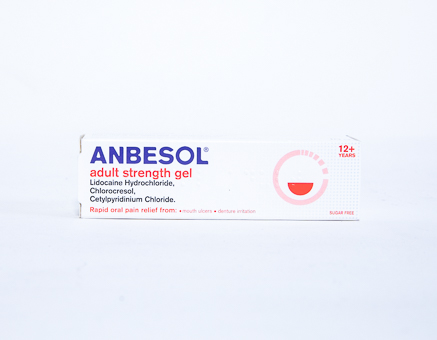Other Options Include
Although mouth ulcers are normally harmless and tend to clear up by themselves within a week or two, treatment options are readily available to help reduce the pain and discomfort associated with them on a day to day basis. Avoiding factors that may aggravate your mouth will help speed up the healing process, reduce the pain you experience and decrease the chance of ulcers recurring. When dealing with mouth ulcers you should avoid eating spicy, acidic, crunchy and hard food along with chewing gum and toothpaste containing sodium lauryl sulfate, alternatively you should have soft foods, drink cool liquids through a straw and use soft bristled toothbrushes.
Anbesol
Anbesol’s Adult Strength contains lidocaine hydrochloride, chlorocresol and cetylpyridinium chloride which are all highly beneficial in helping heal mouth ulcers whilst also reducing the amount of pain you experience. Lidocaine hydrochloride is an anesthetic vital in decreasing the pain you feel and chlorocresol and cetylpyridinium chloride kill the bacteria caused by the ulcer. All three ingredients combined provide a useful and effective way to stop irritation and pain giving your mouth respite to help it heal.
Age Range
This is for adults and children aged 12 or above.
How to Use?
Make sure to read the leaflet before use.
Wash your hands before and after using this product.
Squeeze a small amount on to your fingertip
Slowly dab and massage onto the affected area
Do not apply more often than every 3 hours.
Pregnant or Breastfeeding
If you are pregnant or breastfeeding, ask your doctor for medical advice before using this medicine.
Precautions
Consult your doctor or pharmacist before using Anbesol if:
You have any open wounds or injured areas in the lining of your mouth
If your symptoms persist after 7 days or reappear often.
Side Effects
With any medicine, you may experience side effects, however not everyone experiences them. If you experience any of the following, contact your doctor straight away for medical attention:
Allergic reactions (difficulty in breathing, rash or itchiness of the skin, swollen face or tongue
Dermatitis (inflammation of the skin, this can cause redness).


